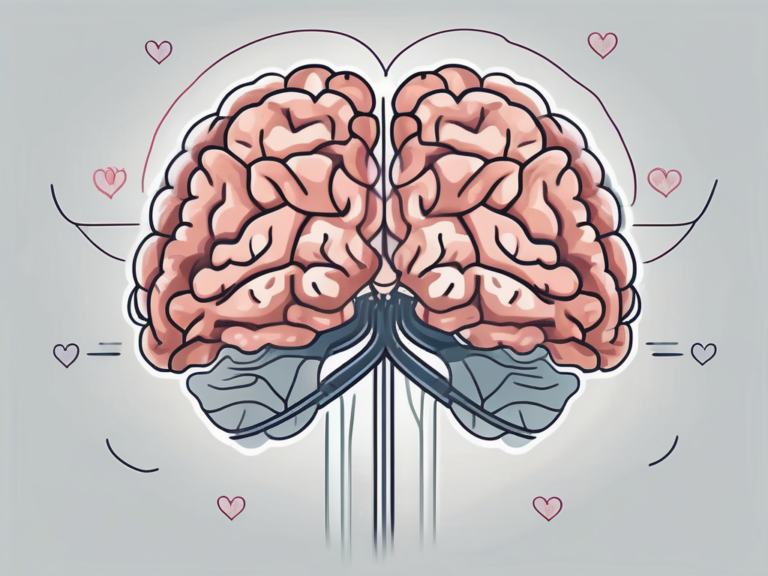The Importance of the Trochlear Nerve: Why I Heart It
Have you ever stopped to think about the incredible intricacies of the human body? From the beating of our hearts to the blink of an eye, every tiny detail plays a vital role in our overall well-being. One such unsung hero that deserves our attention is the trochlear nerve. Trust me, once you learn more about this little-known nerve, you’ll be as smitten with it as I am!
Understanding the Trochlear Nerve
Let’s start by unraveling the mystery of this remarkable nerve. The trochlear nerve, also known as the fourth cranial nerve, is responsible for the movement of one of our most precious assets – our eyes! Positioned deep within our brain, this nerve is often overlooked, but its importance cannot be underestimated.
The trochlear nerve is a fascinating component of our nervous system, playing a crucial role in our ability to perceive the world around us. Its intricate connections and functions contribute to the seamless coordination of eye movements, allowing us to engage with our environment in a dynamic and fluid manner.
Anatomy of the Trochlear Nerve
The trochlear nerve originates in the upper part of our brainstem and extends backwards to a small region known as the trochlear nucleus. From there, it exits the skull and travels to the muscles that control eye movement.
As the trochlear nerve navigates its path through the intricate network of our nervous system, it interacts with various structures and pathways that contribute to its overall function. This complex journey highlights the precision and coordination required for the trochlear nerve to fulfill its role in facilitating eye movements with remarkable accuracy.
Functions of the Trochlear Nerve
Now, let’s dive into what the trochlear nerve does. Its primary role is to control the superior oblique muscle, which regulates the up and down movement of our eyes. This intricate dance between the trochlear nerve and this muscle allows us to look up and down without a hitch!
Furthermore, the trochlear nerve’s involvement in eye movements extends beyond simple up and down motions. It also contributes to the rotational movements of the eyes, allowing us to track moving objects and maintain visual stability during dynamic activities. The trochlear nerve’s multifaceted functions underscore its significance in our visual perception and overall sensory experience.
The Trochlear Nerve and Vision
Ah, vision, the window to the world! The trochlear nerve has a significant impact on our ability to see clearly and navigate the world around us.
The trochlear nerve, also known as the fourth cranial nerve, plays a crucial role in the complex system that governs our vision. This nerve originates from the dorsal aspect of the midbrain and innervates the superior oblique muscle of the eye. This seemingly small component of our nervous system is responsible for a myriad of intricate functions that contribute to our visual experiences.
Role in Eye Movement
Picture this: you’re strolling through a serene forest, and a magnificent bird catches your attention. Without the trochlear nerve, your eyes wouldn’t be able to follow the bird’s graceful flight through the trees. It’s the trochlear nerve that enables smooth eye movements, allowing us to track objects and take in all the wonders around us.
Moreover, the trochlear nerve is particularly essential for the movement of the eye in a downward and outward direction. This downward and outward movement, known as depression and abduction, respectively, is crucial for various visual tasks such as reading, driving, and even simple activities like walking down the stairs without tripping.
Impact on Depth Perception
Ever tried catching a baseball mid-air? Thank the trochlear nerve for that incredible feat! This nerve ensures that both of our eyes move in sync, enabling us to perceive depth accurately. It’s this teamwork between both eyes that allows us to thread the needle and make those unforgettable diving catches!
Furthermore, the trochlear nerve aids in maintaining binocular vision, where both eyes work together to create a single, unified visual image. This coordination is vital for tasks that require depth perception, such as driving, playing sports, or even pouring a cup of coffee without spilling. The trochlear nerve’s contribution to our depth perception highlights its intricate role in our day-to-day activities and the seamless functioning of our visual system.
Disorders Associated with the Trochlear Nerve
Alas, even our resilient bodies can experience hurdles. When it comes to the trochlear nerve, there are a couple of conditions that can pose challenges.
The trochlear nerve, also known as the fourth cranial nerve, is a delicate structure responsible for the innervation of the superior oblique muscle of the eye. This small but mighty nerve plays a crucial role in controlling the movement and position of the eyeball, particularly in looking downward and inward. Any disruption to its function can lead to significant visual disturbances and eye movement abnormalities.
Trochlear Nerve Palsy
Trochlear nerve palsy occurs when this nerve is damaged or impaired, leading to weakness in the superior oblique muscle. This can result in double vision and difficulty moving the affected eye. Thankfully, with proper medical intervention and rehabilitation, individuals with trochlear nerve palsy can make strides towards recovery.
Rehabilitation for trochlear nerve palsy often involves a combination of visual exercises, prism glasses, and in some cases, surgical interventions to correct muscle imbalances. The goal of treatment is to improve eye alignment, reduce double vision, and restore normal eye movements, ultimately enhancing the individual’s quality of life and visual function.
Causes and Symptoms of Trochlear Disorders
Trochlear nerve disorders can arise due to various factors, such as head trauma, infections, or underlying medical conditions. Symptoms may include double vision, eye misalignment, and headaches. If you ever experience these symptoms, it’s essential to consult with a healthcare professional for an accurate diagnosis and proper guidance.
Diagnosing trochlear nerve disorders typically involves a comprehensive eye examination, imaging studies such as MRI or CT scans, and possibly electrophysiological tests to assess the nerve’s function. Treatment options may vary depending on the underlying cause of the disorder, ranging from conservative management with medications and vision therapy to more invasive approaches like surgery in severe cases.
The Trochlear Nerve’s Connection to the Heart
Now, prepare to have your mind blown. Did you know that the trochlear nerve has more connections than just to our eyes? It turns out, it also has an intriguing link to our heart’s health.
The trochlear nerve, also known as the fourth cranial nerve, is primarily responsible for the motor function of the superior oblique muscle in the eye. However, its reach extends beyond ocular movements. This nerve, one of the smallest in the human body, travels a complex pathway from the brainstem to the eye, but along the way, it sends branches that contribute to the autonomic nervous system’s regulation, which includes functions like heart rate and blood pressure.
The Nervous System and Heart Function
Our heart, a tireless muscle, relies on signals from our nervous system to keep pumping. The trochlear nerve plays a role in facilitating communication between the heart and the brain, ensuring this essential organ keeps beating in rhythm.
Furthermore, the autonomic nervous system, divided into the sympathetic and parasympathetic branches, controls involuntary bodily functions. The trochlear nerve’s involvement in this intricate network highlights its significance beyond its well-known role in eye movement.
Trochlear Nerve’s Influence on Cardiovascular Health
Recent research suggests that the trochlear nerve may have an impact on cardiovascular health. While the precise mechanisms are still being unraveled, it’s fascinating to think about the hidden connection between our eyes and our heartbeats.
Understanding the trochlear nerve’s potential influence on cardiovascular health opens up new avenues for exploring treatments that target both ocular and cardiac conditions. This interplay between seemingly unrelated systems underscores the complexity of the human body and the ongoing discoveries that continue to expand our knowledge of its inner workings.
Protecting and Maintaining Your Trochlear Nerve Health
Now that we appreciate the trochlear nerve’s importance, let’s explore ways to keep it in top-notch condition. The trochlear nerve, also known as the fourth cranial nerve, plays a vital role in controlling the superior oblique muscle of the eye, which helps with downward and inward eye movements. This nerve is the smallest of all the cranial nerves and is particularly susceptible to damage due to its long course and unique anatomical pathway.
Healthy Habits for Nerve Health
First and foremost, maintaining overall well-being through a healthy lifestyle is key. This includes regular exercise, a balanced diet rich in nutrients like vitamin B12, which is essential for nerve health, and ample rest. Engaging in activities that promote relaxation, such as yoga or meditation, can also benefit nerve function. Remember, the healthier our bodies are, the better equipped our nerves, including the trochlear nerve, will be to face any challenges that come their way.
Additionally, incorporating foods rich in antioxidants, such as berries, nuts, and leafy greens, can help protect nerve cells from damage caused by free radicals. Adequate hydration is also crucial for maintaining optimal nerve function, as water is essential for transmitting electrical signals throughout the nervous system.
Medical Interventions for Trochlear Nerve Disorders
If you or someone you know is grappling with trochlear nerve issues, fear not! There are a range of medical interventions available, including medication to manage symptoms such as double vision or eye misalignment, physical therapy to improve eye movements, and in some cases, surgery to correct structural abnormalities affecting the nerve. Remember, it’s crucial to work closely with healthcare professionals, such as neurologists or ophthalmologists, who specialize in these matters to guide you on the best course of action tailored to your specific condition.
The Future of Trochlear Nerve Research
As our understanding of the trochlear nerve continues to grow, so does the potential for groundbreaking discoveries.
Exploring the intricate network of the trochlear nerve opens up a world of possibilities for researchers. From its role in coordinating eye movements to its potential impact on overall health, the trochlear nerve remains a fascinating subject of study.
Current Research Trends
Scientists around the world are dedicated to unraveling the trochlear nerve’s mysteries. Cutting-edge research is shedding light on its intricate connections, potential regenerative properties, and new treatment options.
Recent studies have delved into the trochlear nerve’s interactions with other cranial nerves, highlighting its crucial role in maintaining optimal vision and eye coordination. The quest to unlock the full potential of this nerve drives researchers to explore innovative techniques and technologies.
Potential Breakthroughs in Trochlear Nerve Treatment
Who knows what the future holds? Perhaps we’re on the cusp of revolutionary breakthroughs that could significantly impact the lives of those affected by trochlear nerve disorders. Keep an eye on the horizon, and be excited about the possibilities that lie ahead!
As researchers delve deeper into the trochlear nerve’s functions, new avenues for treatment and therapies emerge. The potential for regenerative medicine to restore damaged trochlear nerves offers hope for individuals grappling with neurological conditions.
In conclusion, the trochlear nerve, often overlooked but undeniably important, is the unsung hero behind our eye movements and possibly even our heart health. So, let’s take a moment to appreciate this incredible nerve and the wonders it brings to our lives. From the blink of an eye to the beat of our hearts, the trochlear nerve plays a starring role in our journey through the world. Embrace it, celebrate it, and remember to cherish all the marvelous details that make us who we are!






